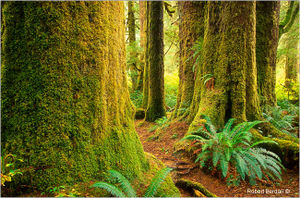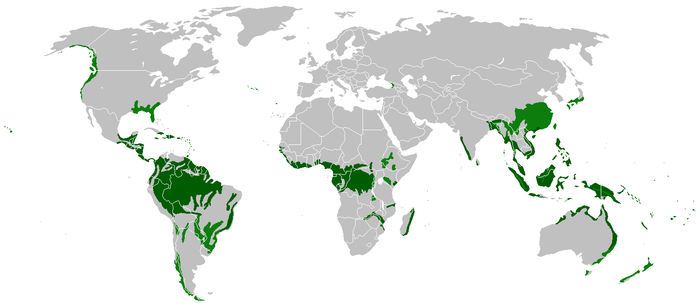Rainforest

Rainforests are a type of forest characterized by their thick tree density (closely spaced, tall trees), large annual rainfall (at least 200 cm) and high specie diversity. Rainforests cover over fifteen percent of the Earth’s surface and contain over half of the world’s terrestrial species. These forests maintain their high humidity through a process called transpiration where the plants take in thousands of liters of water every year and then release most of it back into the atmosphere. This process is viable to keep the rainforests moist in cases where it doesn’t rain for long periods of time. Rainforests generally have a dense canopy and are major influences on carbon storage, with hundreds of billions of tons of atmospheric carbon stored.[2]
However due to land use and agriculture, massive amounts of rainforest are being cut down every year. This deforestation releases many tons of carbon dioxide equivalent. This release is more than 10% of the annual global human caused greenhouse gas emissions.
There are two types of rainforests, temperate and tropical. Tropical rainforests are found generally near the equator while temperate rainforests are found farther north along the coastal regions of North America. The majority of temperate rainforests are found in Canada and the United States. The bulk of tropical rainforests occur in South America and Southeast Asia.[2]

References
- ↑ Dr. R. Brendan (2011, 05, 28). The Carmanah Valley an Ancient Rainforest on Vancouver Island [Online]. Available: http://www.canadiannaturephotographer.com/ancient_rainforest.html
- ↑ 2.0 2.1 R. Buttler, Mongabay. Rainforests [Online]. Available: http://rainforests.mongabay.com
- ↑ Wikimedia Commons, Ville Koistinen (2007, 02, 21). Rain Forest Location Map [Online]. Available: https://commons.wikimedia.org/wiki/File:Rain_forest_location_map.png

